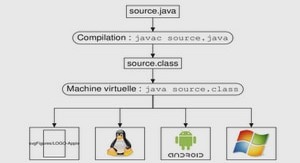Extrait du course Java code conventions
1 – Introduction
1.1 Why Have Code Conventions
Code conventions are important to programmers for a number of reasons:
• 80% of the lifetime cost of a piece of software goes to maintenance.
• Hardly any software is maintained for its whole life by the original author.
• Code conventions improve the readability of the software, allowing engineers to understand new code more quickly and thoroughly.
• If you ship your source code as a product, you need to make sure it is as well packaged and clean as any other product you create.
For the conventions to work, every person writing software must conform to the code conventions. Everyone.
1.2 Acknowledgments
This document reflects the Java language coding standards presented in theJava Language Specification,from Sun Microsystems, Inc. Major contributions are from Peter King, Patrick Naughton, Mike DeMoney, Jonni Kanerva, Kathy Walrath, and Scott Hommel. This document is maintained by Scott Hommel. Comments should be sent to shommel@eng.sun.com
2 – File Names
This section lists commonly used file suffixes and names.
4 – Indentation
Four spaces should be used as the unit of indentation. The exact construction of the indentation (spaces vs. tabs) is unspecified. Tabs must be set exactly every 8 spaces (not 4).
4.1 Line Length
Avoid lines longer than 80 characters, since they’re not handled well by many terminals and tools.
Note:Examples for use in documentation should have a shorter line length—generally no more than 70 characters.
4.2 Wrapping Lines
When an expression will not fit on a single line, break it according to these general principles:
• Break after a comma.
• Break before an operator.
• Prefer higher-level breaks to lower-level breaks.
• Align the new line with the beginning of the expression at the same level on the previous line.
• If the above rules lead to confusing code or to code that’s squished up against the right margin, just indent 8 spaces instead.
Here are some examples of breaking method calls:
someMethod(longExpression1, longExpression2, longExpression3,longExpression4, longExpression5);
var = someMethod1(longExpression1,
someMethod2(longExpression2,
longExpression3));
Following are two examples of breaking an arithmetic expression. The first is preferred, since the break occurs outside the parenthesized expression, which is at a higher level.longName1 = longName2 * (longName3 + longName4 – longName5)
+ 4 * longname6; // PREFER
longName1 = longName2 * (longName3 + longName4
– longName5) + 4 * longname6; // AVOID
Following are two examples of indenting method declarations. The first is the conventional case. The second would shift the second and third lines to the far right if it used conventional indentation, so instead it indents only 8 spaces.
…….
Course Java code conventions (152 KO) (Cours PDF)




